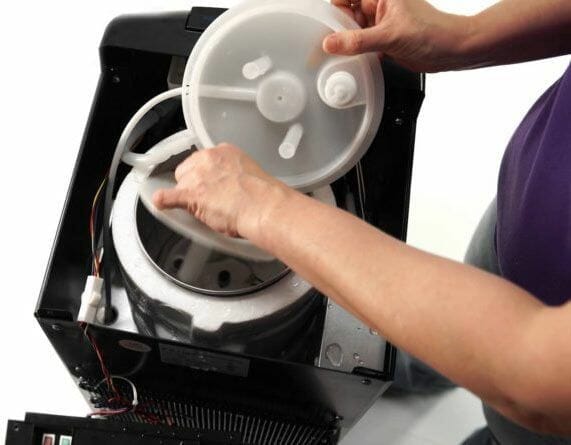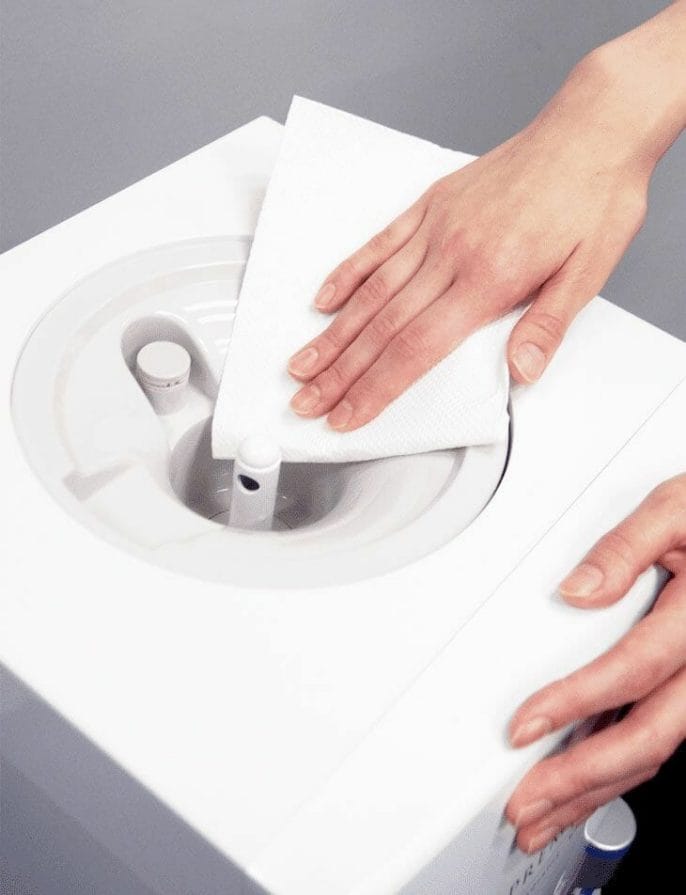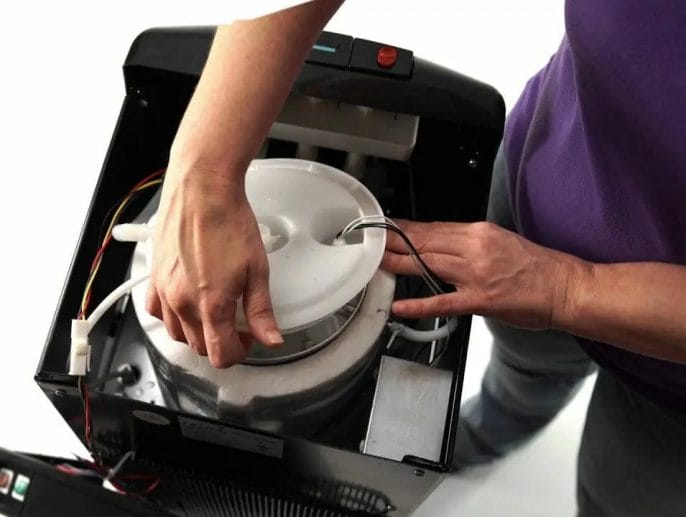How To Clean A Primo Water Cooler
Water is an odorless, tasteless, and transparent substance and is the most important of all survival needs. It helps maintain body temperature and the proper functioning of body organs.
Water dispensers are machines that either cools or heats water and passes it out through a refrigeration unit. A water dispenser is most often known as a "water cooler," and a Primo Water Dispenser is a good option.
Since a dispenser is used to store water, learning how to clean Primo Water Dispenser is key to having clear and healthy water.
How to Clean a Primo Water Dispenser?
Does your Primo Dispenser need cleaning? YES! It is important to note that every machine comes with an instruction manual. They exist for many reasons. Primo Water Dispenser manuals come with a maintenance section. So, to thoroughly clean your Primo dispenser, you will need:
- 2 tablespoons of regular unscented bleach, or 2 cups of distilled white vinegar
- 1 two-gallon bucket
- A sponge
- Small funnel
- Philips head screwdriver
Ready to clean? Here's how:
Make Your Cleaning Solution
In a bucket, pour two tablespoons of bleach into two gallons of hot water. Wear a disposable glove to avoid any reaction and gently mix the solution. If you are using vinegar, mix the two cups of vinegar with two gallons of hot water together in a bucket.
Take the Dispenser Things Apart

Before doing this, ensure you switch OFF the energy-saving switches of the dispenser five minutes before the cleaning time. Also, unplug the power cord from the wall socket and shift the appliance away from the wall. This will offer you easy access to the back of the dispenser. Then, proceed to remove the dispenser's water bottle. Next is to drain the water from the dispenser's reservoir through the hot and cold taps into a bucket.
Pour the Cleaning Solution Into the Water Cooler
Pour the mixture into the dispenser, make sure the solution fills the reservoir, and allow it to sit for 10 minutes. Clean the inner surface of the machine with a sponge dipped into the cleaning solution.
Scrub Well the Drip Tray and Water Taps

Using the sponge, give the drip tray and water taps a thorough scrub and rinse with clean water. Then, dry thoroughly, so no moisture is left in any tight space.
Rinse the Cleaning Solution
Pour hot water into the dispenser and thoroughly rinse four times. Do this properly to ensure no bleach or vinegar taste remains. At the back of the appliance, place a two-gallon bucket. Remove the drain plug, open the hot and cold taps, and allow it to flush out from the three openings
Clean Your Hands Thoroughly
Wash and dry your hands before touching the dispenser or its parts to avoid further contamination. Replace the drain plug and cap, and lock the hot and cold taps. Then return the appliance to its previous position.Load the dispenser with a fresh water bottle.Plug the power cord back into the wall socketand turn the energy-saving switch back ON
Cleaning Cold Reservoir and Water Lines
Dispenser water lines need a weekly deep cleaning because of lime-scale build-ups, which can reduce your dispenser's life span. Lime-scales are the hard, chalky substance that builds up where water is cold, heated, or left.

To clean this off, use a Philips screwdriver to unscrew the plastic tubing water lines inside your dispenser. Allow the ice builds in the dispenser to defrost thoroughly. Pour 3-4 cups of distilled white vinegar into the water lines through a small funnel. Let it soak to break down lime-scales for about 10 minutes.
Run the vinegar in the water line out through the dispenser hot and cold taps. This will also help break down the lime-scale in the valves. Rinse the water lines with clear water and screw back the plastic tubing water lines.
How to Prevent Having a Dirty Dispenser

Water dispensers help make cold water readily accessible at the click of a button. Like every other appliance, they require periodic cleaning and maintenance. A dirty water dispenser produces germs and bacteria that can cause several severe health conditions like Legionnaires' disease, which grows into pneumonia.
To prevent having a dirty water dispenser:
Follow Instructions
Every product comes with an instruction manual that tells an end-user how to use the product.
According to Vanguard Resources, water coolers should be cleaned whenever a new bottle is to be used or every six weeks.
Make Cleaning a Habit
Research showed that the Heterotrophic Plate Count (HPC) of water coolers exceeded the acceptable level for drinking by over 60%. HPC is a standard for measuring the quality of water and the number of bacteria present in water dispensers.

Maintaining the habit of cleaning your water dispenser regularly can help prevent the development of bacteria inside the water cooler.
The Influence of the Water Source
An inadequate water source can negatively impact health by causing severe infections like diarrhea. Water supplying companies warn against filling tap water into the water cooler, as this can reduce the life span of the cooler.
More so, tap water likely contains elements that build up lime-scales in the dispenser, which can negatively affect health. This can affect both the taste and quality of water from the cooler.
Primo Water Dispenser Troubleshooting

Just like any machine, Primo Water Dispenser might have little set-backs, which is not a problem. Every problem has a solution, right. Here are some troubles you might encounter using your dispenser, and proven solutions:
If Your Water is At Room Temperature
If the water from your dispenser is at room temperature, turn off the dispenser's energy switch. Move the machine away from the wall so you can access the dispenser dial. The dial is located near the rear condenser coil of the dispenser and looks like a gold-brass, screw. With your screwdriver, twist the dial clockwise a bit, then put on the energy switch. It should make your water cold.
If Your Water is Not Dispensing From Either Tap
If the water bottle seal is not set correctly, water will not enter the reservoir. No water in the reservoir means that water will not dispense from the machine. To let you know, the machine will start making a chirping sound, or the Led light will start blinking. To solve this, secure the nozzle and seal the bottle correctly.
If Water is Leaking from the Tap
To fix this issue, no tools are needed. All you need to do is to remove the Primo water bottle, then remove and empty the plastic receptacle. You will also notice there is water where the reservoir was. To remove this water, empty 8-16oz of water from the tap into a cup.
Then, rightly position the receptacle with the squared art aligned with the back edge of the dispenser. You will need to set a new water bottle. So, peel off the seal from the new bottle cap and carefully place it onto the water dispenser.
How to Fix a Slow Flowing Water Dispenser

The Primo water dispenser seems to have this issue after using it for about five to six months. However, a new machine might have a similar problem.
But it is a straightforward fix. The tap nozzle has a filter-like screen that might be clogged because of some tiny particles from the water bottle. The tap nozzle has an edge-like feel. So, using a plier, pull the nozzle out and give it a proper cleaning. It should get the water flowing freely again.
To fix this issue on a new dispenser, hold down the cradle for 2 to 3 minutes. It will fill up the reservoir with water.
5 Tips for Cleaning Your Water Dispenser
How to Know When it's Time to Clean Your Water Dispenser
Tips on Cleaning Your Primo Water Dispenser
- Remove all debris and empty the reservoir thoroughly.
- Fill the reservoir with vinegar, add some dish soap, and then run a cycle through your machine as usual.
- Then refill your machine with fresh water and run a usual cycle through it.
- Wash your water reservoir with warm water and dish soap to remove stickers and labels.
- If the exterior of your dispense
How do you clean a Primo water dispenser tray?
The Primo water dispenser is a popular product among water drinkers. However, as much as we love our Primos, we must clean them every once to avoid any buildup of bacteria and mold.
- Open the tank lid by turning it counterclockwise with your fingers until it pops open.
- Remove the dispenser tray by pulling up the black tabs on either side of it.
- Put a cup or glass under the spout and turn on the water to flush away any debris that might still be stuck in there.
- Rinse off the tray with warm soapy water and use a soft cloth or sponge to scrub off any stubborn stains.
- Dry off or rinse off excess water to prevent skin from becoming irritated
How do you clean a 5-gallon water dispenser?
A water dispenser is an essential part of a modern office. With a water dispenser, you can give your employees plenty of freshwaters to drink at any time. However, it can be challenging to keep the water in the dispenser clean. If you don't clean it often, mold and bacteria will grow inside and clog the pipes.
To make sure that your dispenser is always ready for use here is how to clean a 5-gallon water dispenser:
Step 1: Take the water dispenser out of the fridge and place it on a protected surface.
Step 2: Take the top apart and remove all components. Put them in a safe place - this will help you keep track of where everything goes.
Step 3: Use a soft, clean cloth or paper towels to dry the exterior surfaces.
Step 4: Soak all the parts that cannot be put in the dishwasher - filter, faucet nozzle, faucet lever, spigot tube, spigot nut.
Step 5: Soak removable components in vinegar and hot water for ten minutes before rinsing off.
Step 6: Remove
How do you clean a water cooler dispenser with vinegar?
What you will need:
- A few cups of white vinegar
- Baking soda
- A rag
- Paper towels
It's important to clean your water cooler dispenser regularly to prevent the buildup of bacteria. It's also important to make sure that you are using a safe cleaning product for this task. The market offers a variety of products, one easy and effective solution is vinegar.
- Spray vinegar on the parts of the dispenser that are hard to reach with a spray bottle and let it sit for 20-30 minutes.
- Pour hot water over all parts of the dispenser, including where you sprayed with vinegar earlier. As a result, any bacteria or fungus that may be lurking in these areas
- Rinse all parts thoroughly with cold water before switching on and testing if they work correctly.
How do you clean the bottom of a water dispenser?
Make sure the water dispenser is unplugged.
Carefully unscrew the bottom of the water dispenser using a Phillips screwdriver.
Use a dishcloth or sponge to wipe away any dirt and debris from inside the tank.
Clean away any residue from around the pump and then plug it back in to start making ice cold water again.
Step 1: Cut off your water supply and take out the water filter.
Step 2: Fill a bucket with hot soapy water and clean the exterior of the dispenser.
Step 3: Clean the bottom and top dishwasher door where water accumulates with a damp cloth or sponge.
Step 4: Disconnect all hoses from inside the machine and wipe down any sediment that may have accumulated.
Step 5:
- Unplug your appliance.
- Remove any power cables from it.
- Then take out your appliance.
Step 6: Give it a good scrub on all sides using some detergent or soap for a more thorough clean.
After it has dried, let it air dry in an open space until you are ready to put it back together again.
How to clean primo water dispenser model 60113 0
Using a water filter is one of the most effective ways to decrease tap water's chemical and heavy metal content. A water filter can be used in place of a primo or Brita faucet attachment to allow you to enjoy clean and healthy water from your tap. You will learn how to replace your primo faucet attachment with a more efficient, modern, and healthier option in this guide. Step 1: Take out the water filter from the dispenser. Step 2: Pour hot water into a bucket and dissolve 2-3 scoops of dishwasher detergent in it. Step 3: In the soapy water, dip a clean sponge and scrub off any food residue from the inside of the dispenser. Rinse off with hot water. Step 4: Remove any debris around the dispenser's base, such as bird droppings and leaves. Step 5: Rinse off outside surfaces with warm water and dry thoroughly - do not use a wiper blade to dry.
5 Tips for Cleaning Your Water Dispenser
How to Know When it's Time to Clean Your Water Dispenser
Tips on Cleaning Your Primo Water Dispenser
- Remove all debris and empty the reservoir thoroughly.
- Fill the reservoir with vinegar, add some dish soap, and then run a cycle through your machine as usual.
- Then refill your machine with fresh water and run a usual cycle through it.
- Wash your water reservoir with warm water and dish soap to remove stickers and labels.
- If the exterior of your dispense
Cleaning a Primo Water Dispenser Video
How to Clean Primo Water Dispenser FAQs
1. Will the Water Taste Better After Cleaning the Dispenser?
Yes. To enjoy clean water taste, your water dispenser should be cleaned and maintained to prevent bacteria build-up. Sanitize your dispenser every six months.
2. How Can I Get the Bleach Taste Out of My Dispenser?
The reason your dispenser has bleach taste is that the bleach used in washing the machine was not properly rinsed out. To rid your dispenser of this taste, rinse your dispenser with hot water at least four times.
3. How Should I Store My Dispenser When Traveling?
To keep your water dispenser safe while on a trip, unplug it and drain out water from the reservoir. Leave it dry until you are ready to use it again.
4. Does Water Dispenser Purify Water?
Some water dispensers are designed to serve as water purifiers and dispense 100% clean water. Most also come with a hot and cold dispensing tap.
5. Can you use any water with a primo water dispenser?
The answer is no. While any water can be used in a regular water dispenser, Primo's tap water is appropriate for Primo's filtered water dispenser.
In Primo's opinion, there are two reasons for this. First, the tap water has been pre-filtered to meet Primo's stringent quality standards, and second, it provides an extended shelf life compared to bottled or filtered water.
6. Do water dispensers need to be cleaned?
The answer is yes; they do need to be cleaned. One of the biggest reasons for this is because water dispensers accumulate a layer of mineral deposits in the water tank, which will eventually lead to a bad taste in the water.
This article discusses why water dispensers need to be cleaned and some tips on how to get it done. It also gives some advice on how one can avoid having to clean their water dispenser in the first place.
7. Will the water taste better after cleaning the dispenser?
It's recommended that you clean your dispenser at least once a month. If you neglect the maintenance, your water will start to taste bad and may not be safe to drink.
If you are too busy to do it yourself, contact a professional who can do it for you.
8. How do you disinfect your water dispenser?
It is important to know how to disinfect your water dispenser. Many people don't know how to clean their water dispensers, and they can be spreading diseases. If you are a parent, you should know that children are more susceptible to the diseases that could come from the bacterias and other germs on a water dispenser. There are some simple steps that you can take to make sure that your family is safe from any illnesses.
- Use soap and hot water for cleaning the exterior of the machine
- Rinse with cold water
- Pour 1/4 cup of bleach into the reservoir
- Run water through machine for about 5 minutes
- Turn off the power supply line
9. How often should i clean your top loading water dispenser?
Failure to clean your water dispenser leads to odor, buildup, and mold.
The frequency with which you need to clean your water dispenser depends on the type of water in your area, the type of water dispenser you have, and how often you use it.
If you use a top loading water dispenser and live in a rural area where the quality of tap is high, then you can probably go without cleaning for months at a time.
However if you live in an urban or suburban area where tap quality is slightly lower than what you would find in rural areas, then cleaning every few weeks is recommended.
10. How do you get mold out of a water dispenser?
Here are few ways to remove mold from a water dispenser.
1. Clean the area around the dispenser with soap and water then let it dry.
2. Mix 1 tablespoon of bleach and 1 gallon of water together in a container then pour it into the dispenser until the bleach is mixed in thoroughly. Let this stand for 30 minutes before you use it again.
3. Place half a lemon on top of the spout at night before going to bed, this will help keep your water fresh during your sleep cycle without you having to do anything else in the morning, but remember that you need to rinse it out in the morning or else your lemon will rot inside!
4. Purchase/make a scrubber specifically designed for cleaning spouts with vinegar or baking soda diluted with water. Add a few teaspoons of vinegar or baking soda to water (enough to fill the jar), and shake well.
Conclusion
Water dispensers are great investments. They can be trusted to serve and produce water anywhere and at the nick of time.
Though Primo water dispensers develop issues over time, as most machines do, they are easy to fix. They also offer a cold and hot water feature that is adjustable to suit any weather condition.
Knowing how to clean Primo water dispenser will offer you the privilege of staying healthy and free from bacterial infections and lime-scale build-ups.
How To Clean A Primo Water Cooler
Source: https://www.waterev.com/how-to-clean-primo-water-dispenser/
Posted by: ellisbelve1990.blogspot.com

0 Response to "How To Clean A Primo Water Cooler"
Post a Comment